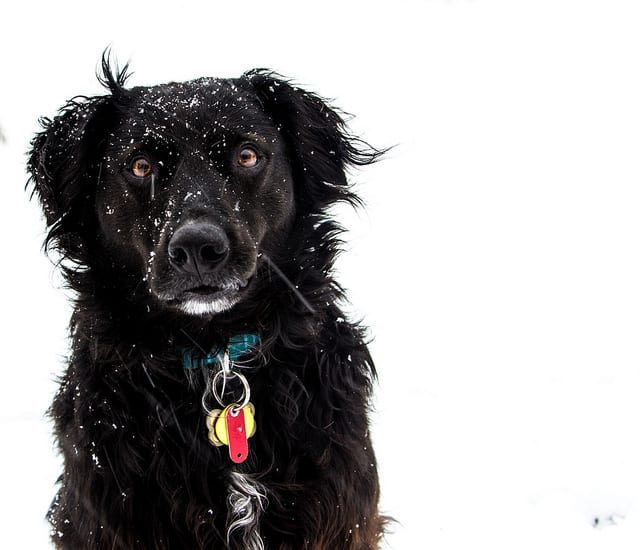How to Protect Your Dog This Coming Winter
Posted by Lora Shaw on October 21, 2015
 Whether or not you have accepted it, the fact remains that winter is right around the corner! And for dog owners in particular, this means taking your dog out and walking them – even when it is freezing cold. It is important to remember that your dog’s safety and well-being is just as important as your safety and well-being when it comes to keeping them warm in the frigid temps.
Whether or not you have accepted it, the fact remains that winter is right around the corner! And for dog owners in particular, this means taking your dog out and walking them – even when it is freezing cold. It is important to remember that your dog’s safety and well-being is just as important as your safety and well-being when it comes to keeping them warm in the frigid temps.
Here are some winter tips for dog owners, like yourself, who are looking for clever ways to keep your pup warm during the bitter winter months.
The Dangers your Dog Can be Exposed to in the Winter
Chemicals on the Sidewalks– It is normal for chemical treatments to be applied to the sidewalks during the winter. Most of these treatments are pet-friendly, but you never know if every neighbor uses pet-friendly versions or not. Thus, it is better to be safe than sorry. To protect your pup from these chemicals, you can outfit his paws with snow booties. If he does not take well to wearing his new shoes, we recommend wiping his paws with warm water immediately after coming inside. Also, you want to get in the habit of checking his paws for any abrasions or cuts as the cold weather can dry his paws out, causing cracking and splitting.
Anti-Freeze Poisoning- In the winter months, it is common to change out the anti-freeze in your car, but please be careful of accidental spills in the driveway or garage. Anti-freeze has a sweet scent and taste to animals, causing them to be attracted to it. However, once ingested, it is dangerously toxic to them. If you have any spills, it is imperative that they are cleaned up right away. We cannot stress this one enough! Please be careful with anti-freeze and be sure to clean up any spills. If you do suspect that your pet has ingested anti-freeze, take him to the vet or the nearest animal hospital immediately!
Frost Bite– If you have little ones then you know all about protecting them before they go play in the snow, but keep in mind that your four-legged friend needs protection too! Frost bite can happen to our pets just as easily as our children. When the body becomes cold for a long period of time, the blood is diverted to our core body systems and organs; therefore, blood flows away from the extremities, such as the nose, feet and hands.
Your dog’s body operates the exact same way, so they, too, can be susceptible to frost bite. It is imperative that you limit their time outdoors during the cold winter months. When your dog is feeling cold, their behaviors may change. They may begin to move slower and even lift their paws out of the snow more frequently to avoid the bitter cold on their paws. It is important to watch for these signs and know the symptoms of frost bite:
- Tissues and skin will appear grayish in color
- Skin is hard to the touch
- When inside, the thawing skin will turn red (this usually hurts and your dog may excessively lick)
- If the frost-bite is severe, the skin will eventually turn black and fall off
In order to prevent frost bite in your pup, we recommend dog booties or socks (if they will tolerate it) and some sort of doggie sweater (again, if they tolerate it). These may look silly to some people, but they actually do help in keeping your dog warm. Also be conscious of the time you are allowing your dog to play outside. Bring him in more frequently and have a warm, cozy bed that he can curl up in to keep warm.
· Outdoor Shelter– If you have to keep your dog outside for an extended period of time, make sure he has adequate shelter. You can even purchase an insulated dog house to have outdoors to keep him warm and protected from the elements.
· Plenty of Food– If your dog is going to be outside for an extended period of time, he will need to be fed 10-20% more food than normal. He will need the extra calories to generate more body heat. Also, consider a heated water bowl to keep the water thawed out. Dehydration can occur in the colder months as well.
· Shovel a Path– Smaller dogs appreciate this one! Their legs can get buried in the snow, making it extremely difficult to walk. Shovel a path with a space to go to the bathroom so that their feet and legs will not get cold. Some dogs will not go outside to relieve themselves if there is not an area to walk. This could cause messes on your floor inside as a result of their discomfort.
We hope these winter tips have helped to educate you, the dog owner, on how you can make your pup’s life a little more cozy and comfortable during the winter months. We all have to survive the harsh winters together, including our furry friends!

Categories: All Posts, Dogs, Pet Safety
Archives
Recent Articles
Categories
Monthly Archive
- April 2025
- March 2025
- February 2025
- January 2025
- December 2024
- November 2024
- October 2024
- September 2024
- August 2024
- July 2024
- June 2024
- May 2024
- April 2024
- March 2024
- February 2024
- January 2024
- December 2023
- November 2023
- October 2023
- August 2023
- July 2023
- June 2023
- May 2023
- April 2023
- March 2023
- February 2023
- January 2023
- December 2022
- November 2022
- October 2022
- August 2022
- July 2022
- June 2022
- April 2022
- March 2022
- February 2022
- November 2021
- October 2021
- November 2020
- September 2020
- July 2020
- March 2020
- January 2020
- November 2019
- September 2019
- July 2019
- March 2019
- January 2019
- December 2018
- November 2018
- October 2018
- August 2018
- July 2018
- June 2018
- May 2018
- April 2018
- March 2018
- February 2018
- January 2018
- December 2017
- November 2017
- October 2017
- September 2017
- August 2017
- July 2017
- June 2017
- May 2017
- April 2017
- March 2017
- February 2017
- January 2017
- December 2016
- November 2016
- September 2016
- August 2016
- July 2016
- June 2016
- May 2016
- April 2016
- March 2016
- February 2016
- December 2015
- November 2015
- October 2015
- September 2015
- August 2015
- July 2015
- May 2015
- March 2015
- February 2015
- January 2015
- December 2014
- November 2014
- September 2014
- August 2014
- July 2014
- June 2014
- May 2014
- March 2014
- February 2014
- January 2014
- December 2013
- November 2013
- October 2013
- September 2013
- August 2013
- June 2013
- May 2013
- March 2013
